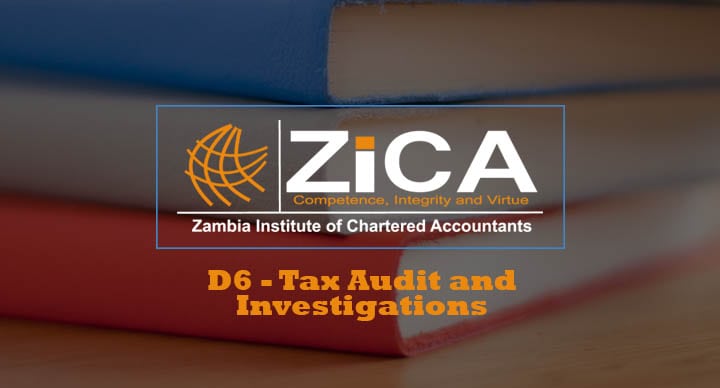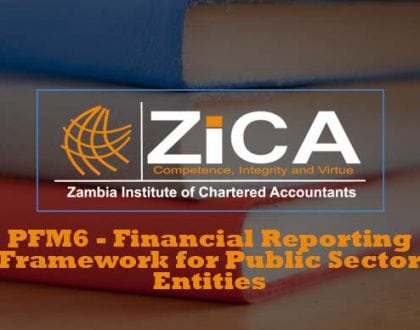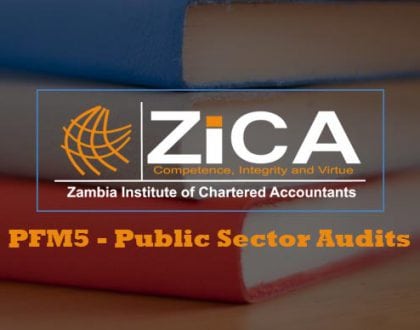D6-Tax Audit and Investigations
No access plans exist.

Course Features
Course Details
D6-TAX AUDIT AND INVESTIGATIONS
This Paper introduces students the wider concepts of auditing and investigations with the sole purpose of detecting under declarations of Income or over statements of expenditure. The Paper also covers issues of fraud detection and the examination of financial records in arriving at assessed tax.Objectives
On completion of this paper, the student should be able to:- Undertake a detailed examination of financial statements and come up with a tax assessment;
- Undertake a detailed Tax Audit;
- Undertake a detailed Tax Investigation;
- Respond to either Audit or Investigation queries from the Zambia Revenue Authority.
Structure of the examination paper
There shall be a three hour examination consisting of four (4) compulsory questions of twentyfive (25) marks each. Candidates will be allowed fifteen minutes’ reading and planning time.Detailed Syllabus
- UNIT 1 - THE FRAMEWORK OF AUDITING IN GENERAL
- Element 1: Nature, Purpose and Scope of Tax Audits
- Element 2: Auditing Theory
- Element 3: Audit Evaluation & Planning
- Element 4: Evidence Collection and Analysis
- Element 5: Performance of the Audit
- Element 6: Audit Reporting Framework
- UNIT 2 - TAX AUDITS
- Element 1: Introduction to Tax Audits
- Element 2: Elements of a Qualitative Tax Audit
- Element 3: Audit Process Flow Chart
- Element 4: Place of Examination
- Element 5: Taxpayer Involvement in Business Affairs
- Element 6: Taxpayer and Spouse
- Element 7: Third party Contacts
- Element 8: No Records or Inadequate Records
- Element 9: Basis of Accounting
- Element 10: Gross Receipts or Turnover
- Element 11: Use of Ratio Analysis
- Element 12: Business Expenses
- UNIT 3 - THE ROLE OF THE TAXPAYER AUDIT PROGRAM
- Element 1: The Roles of the taxpayer audit program
- Element 2: Types of Audit
- Element 3: The Audit Context – administrative assessment versus self-assessment
- UNIT 4 - LEGAL FRAMEWORK
- Element 1: Why have a Legal Framework?
- Element 2: Taxpayer’s Record Keeping Obligations
- Element 3: Giving Inspectors Access to Books and Records
- Element 4: Giving Inspectors Access to Third Party Information
- Element 5: Sanctions for Non Compliance
- UNIT 5 - ORGANISATION & MANAGEMENT OF THE TAXPAYER AUDIT FUNCTION
- Element 1: Organisation of Tax Audit Operations
- Element 2: Resources for the Tax Audit Function
- Element 3: Strategic management and the audit function
- Element 4: Operational Management
- Element 5: Performance Objectives and Measurement
- Element 6: Evaluation of Audit Activities
- UNIT 6 - AUDIT TECHNIQUES
- Element 1: Key Principles
- Element 2: Audit Support Tools
- Element 3: Audit Planning
- Element 4: Pre- Contact Analysis & Case Selection Methods
- Element 5: Examination Techniques
- Element 6: Use of Indirect Methods to Verify Income
- Element 7: Working Papers
- Element 8: Finalizing the Audit
- UNIT 7 - EXAMINATION OF FINANCIAL STATEMENTS
- Element 1: Preliminary Review of Financial Statements
- Element 2: Objectives of Accounts Examination
- Element 3: Compliance Risk Management Process
- Element 4: The Balance Sheet
- Element 5: The Income Statement
- Element 6: Review of Tax Computations
- Element 7: Drawings
- Element 8: Stocks
- Element 9: Bad Debts
- Element 10: Depreciation
- Element 11: Advertising Expenditure
- Element 12: Legal and Professional Fees
- Element 13: Salaries & Wages
- Element 14: Travel & Entertainment
- Element 15: Examination Techniques
- UNIT 8 - TAX INVESTIGATIONS
- Element 1: What is a Tax Investigation?
- Element 2: Reasons for a Tax Investigation
- Element 3: Choosing the Investigation Approach
- Element 4: Risk Based Approach
- Element 5: Systems Based Approach
- Element 6: Accounts Examination
- Element 7: Risk Assessment
- Element 8: Taxpayers with Complete Records
- Element 9: Taxpayers with Incomplete Records
- Element 10: Uncovering Hidden Income
- Element 11: Perpetual Tax Loss Positions and Loss Harvesting
- UNIT 9 - AUDITING FAMILY BUSINESSES
- Element 1: Introduction to Family Businesses
- Element 2: Sole Trader
- Element 3: Company
- Element 4: Incorporation
- Element 5: Transferring the Business to a Limited Company
- Element 6: Loans to Effective Shareholders
- Element 7: Loans from Shareholders
- Element 8: Associated Trading Activities
- Element 9: Methods of Profit Extraction from the Family Business
- Element 10: Withdrawing Investment from the Family Business
- UNIT 10 - BUSINESS FINANCE
- Element 1: Financing a company – Long term finance
- Element 2: Financing a Sole trader or partnership
- Element 3: Short Term Finance
- Element 4: Financing Fixed Assets
- Element 5: Deferring or reducing the tax liability of a business
- UNIT 11 - TRANSFER PRICING AUDIT
- Element 1: Enterprises which have significant amount of or various types of related party transactions
- Element 2: Enterprises which have been in long-term consecutive losses, low profitability, or fluctuating profit-and-loss situations
- Element 3: Enterprises whose profit levels are lower than those in the same industry
- Element 4: Enterprises showing an obvious mismatch between their profit levels and their functional and risk profile
- Element 5: Enterprises which have business dealings with related parties in tax havens
- Element 6: Enterprises which have not complied with the reporting of their related party transactions or preparation of contemporaneous documentation
- Element 7: Enterprises obviously violating the arm’s length principle
- UNIT 12 - AUDIT ISSUES IN THE MINING SECTOR
- Element 1: Introduction
- Element 2: The Classification of Capital expenditure
- Element 3: Loan Relationships with Shareholders
- Element 4: Losses from Non-Producing Mines
- Element 5: Separate Profit Statements for each Mine
- Element 6: Separate Reporting for Capital Expenditure for each Mine
- Element 7: Sale of Base Metals & Precious Stones to related parties at Reference Price
- Element 8: Gradual Reduction of Qualifying Capital Expenditure
- Element 9: Clauses from Development Agreements
- UNIT 13 - AUDIT ISSUES IN THE BANKING SECTOR
- Element 1: Introduction Element 2: Separate Source Income
- Element 3: Realisation Basis for Income Recognition
- Element 4: Leasing Income
- Element 5: Derivatives
- Element 6: Accrued Discounts on Government Bonds
- Element 7: Special Deposit Reserve Accounts
- Element 8: Credit Card Income
- Element 9: Converted Exchange Differences
- Element 10: Foreign Exchange Earnings
- Element 11: Fee Income
- Element 12: Bad Debts and Portfolio Provisions
- Element 13: Non Performing Loans
- Element 14: Third Party Guarantees
- Element 15: Interest Suspense Accounts
- UNIT 14 - AUDIT ISSUES IN THE TELECOMMUNICATIONS SECTOR
- Element 1: Introduction
- Element 2: Inter – Connection Charges and their impact on VAT Liability
- Element 3: Tax treatment of Discounts to Air Time Dealers
- Element 4: Tax treatment of Discounts to Subscribers
- Element 5: Tax Treatment of Network Switch Expenditure
- Element 6: Tax Treatment of Roaming Charges & Income
This course does not have any sections.





